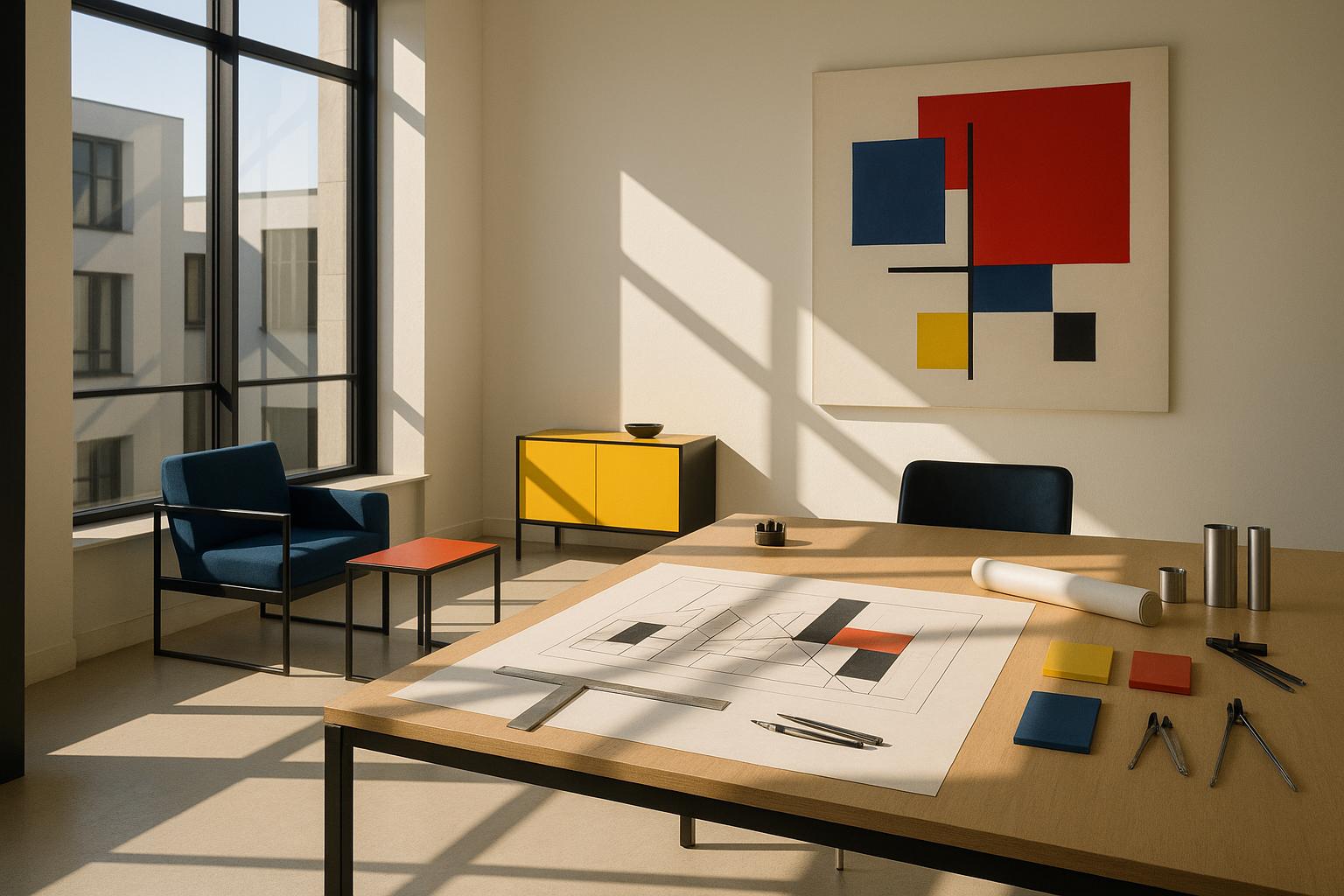Cross ventilation is a natural way to keep indoor spaces cooler, improve air quality, and reduce energy costs. By strategically placing openings like windows on opposite sides of a building, you can create a steady airflow that replaces stale air with fresh air. Here’s what you need to know:
- Energy Savings: Reduces energy use by 20–40%.
- Comfort: Keeps spaces up to 7°F cooler and reduces discomfort on hot days by 58%.
- Air Quality: Filters out pollutants and allergens naturally.
- Cognitive Benefits: Improves task performance by 61%.
Key Design Tips:
- Align buildings with prevailing winds.
- Use larger or adjustable windows for better airflow.
- Place openings at different heights to let warm air escape.
- Keep interiors open and free of obstructions.
Whether you’re designing a home or a large building, cross ventilation offers a simple, cost-effective way to enhance comfort and sustainability. Keep reading for practical design methods, examples, and tools to maximize these benefits.
How to achieve cross-ventilation
Main Design Principles
Grasping the basics of cross ventilation - how air flows and how buildings interact with it - is key to creating comfortable, energy-efficient spaces.
Air Movement Patterns
Cross ventilation works by leveraging wind pressure and temperature differences to move air through a space. When designed well, it can maintain comfort levels 70% of the time, compared to just 1% with single-sided ventilation.
Several factors influence how effectively air moves through a building:
| Factor | Impact on Ventilation | Recommendation |
|---|---|---|
| Opening Size | Affects air velocity | Use a larger inlet and a smaller outlet to increase speed. |
| Distance Between Openings | Influences flow strength | Keep openings closer together for better circulation. |
| Opening Height | Impacts temperature control | Place outlets higher to allow warm air to escape. |
| Air Path Obstruction | Determines flow efficiency | Ensure the air path is clear and free of barriers. |
"Natural ventilation is a low-energy way to keep buildings at a comfortable temperature, but in order to increase its use, we need simple, accurate models that can respond quickly to changing conditions."
– Dr. Megan Davies Wykes, Cambridge's Department of Engineering
Wind-driven forces can boost ventilation rates by as much as 40% beyond what temperature differences alone achieve. These insights lay the foundation for better building placement, which we’ll explore next.
Building Position and Space Planning
While airflow dynamics are critical, the way a building is positioned can amplify these natural forces. A great example is the Kanchanjunga Apartments in Mumbai, which use clever design to maximize ventilation:
- Large, permeable openings face the prevailing winds.
- Double-height terraces serve as buffer zones for airflow.
- Strategically placed verandas enhance air circulation.
To make the most of cross ventilation, consider these strategies:
- Align buildings perpendicular to prevailing winds.
- Reduce the distance between openings.
- Use courtyards or atria to break up deeper floor plans.
Research shows that buildings designed for cross ventilation can achieve air change rates up to 14 times higher than those relying on single-sided ventilation. Even a modest airflow of 160 feet per minute can make a room feel up to 5°F cooler without altering the actual temperature, cutting down on the need for mechanical cooling systems.
Design Methods
Window and Opening Design
Well-thought-out window design can help maintain indoor temperatures within 2.7°F of the outdoor environment. Here are some important design elements to consider:
| Design Element | Recommendation | Impact |
|---|---|---|
| Opening Position | Perpendicular to prevailing winds | Enhances air intake |
| Inlet/Outlet Size | Equal or larger outlet size | Ensures steady airflow |
| Window Type | Maximized ventilation area | Boosts air exchange rate |
| Path Length | Shorter distances between openings | Improves airflow efficiency |
Pairing effective window placement with thermal mass can further stabilize indoor temperatures.
Heat Storage Materials
Thermal mass materials are excellent for storing heat during warmer periods and releasing it when temperatures drop, creating a natural temperature regulation system. Different materials vary in their heat storage capacity:
| Material | Heat Capacity (kJ/m³·K) | Best Application |
|---|---|---|
| Water | 4,186 | Upper-story storage |
| Concrete | 2,060 | Floors and walls |
| Stone | 1,800 | Ground-level mass |
| Brick | 1,360 | Interior walls |
For instance, the Rajiv Gandhi International Airport in Hyderabad uses a combination of thermal mass and natural ventilation to cut energy consumption by 30% compared to traditional designs.
While passive strategies like these are highly effective, adding mechanical controls can take ventilation efficiency to the next level.
Mixed Ventilation Systems
Mixed-mode ventilation systems combine natural and mechanical methods, cutting energy usage by up to 70% compared to fully mechanical systems while improving overall comfort.
The City of Glasgow Colleges showcases an impressive example of mixed ventilation through several strategies:
-
Automated Control System
Sensors monitor indoor conditions and automatically adjust ventilation methods based on real-time data. -
Stack Effect Integration
The atrium functions as a natural ventilation stack, seamlessly collaborating with mechanical systems when necessary. -
Smart Management
Building Automation Systems (BAS) balance natural and mechanical ventilation, ensuring optimal energy efficiency.
This approach has delivered outstanding results. Studies reveal an 18% increase in employee productivity and a 65% reduction in Sick Building Syndrome symptoms.
Current Technologies
Air Flow Analysis Tools
Today’s computational tools have revolutionized cross-ventilation design, making it faster and more efficient. For instance, Ansys Discovery leverages its burst-to-cloud capability to speed up parametric studies by up to 100 times, thanks to simultaneous GPU simulations. The platform offers three distinct modes designed for specific tasks:
| Mode | Function | Primary Use |
|---|---|---|
| MODEL | CAD modification for geometry setup | Setting up geometry |
| EXPLORE | Live Physics GPU solving | Quick, real-time results |
| REFINE | Fluent solving (CPU-based) | Detailed, in-depth analysis |
For smaller-scale projects, tools like Ventus simplify indoor air quality analysis. These tools are becoming even more effective with the integration of AI technologies such as Machine Learning and Deep Learning, which enhance real-time simulation capabilities. These advancements play a critical role in shaping the design of modern facades by providing precise insights into airflow and ventilation performance.
Modern Facade Systems
Modern facade systems seamlessly blend traditional architectural principles with cutting-edge technology to improve cross-ventilation efficiency. One standout example is the double-skin facade, which delivers impressive performance benefits:
| Ventilation Type | Performance Impact |
|---|---|
| Natural Ventilation | Reduces energy costs by 40% |
| Cross-Ventilation | Maintains comfort levels 70% of the time |
| Mechanically Ventilated Double Skin | Cuts heat load by 1.5x at wind speeds of 6 m/s |
A great real-world example is the Pearl Academy of Fashion in Jaipur. This building combines traditional Rajasthani stepwell designs with modern architectural strategies. Its passive cooling system uses the natural stack effect, pulling cool air upward from water features at the base of the structure.
Meanwhile, smart facades equipped with IoT sensors and automation are taking ventilation efficiency to the next level. For instance, The Edge in Amsterdam employs a responsive facade system that works in harmony with natural ventilation strategies. This approach not only enhances indoor air quality but also significantly reduces energy usage.
Other innovations include porous bricks and specialized plasters that improve airflow, as well as reflective coatings that minimize heat absorption, keeping indoor spaces cooler even in warmer climates. These advancements demonstrate how modern facade systems are redefining the way buildings interact with their environment.
sbb-itb-1be9014
Example Projects
Real-world projects highlight how cross ventilation principles can enhance both comfort and energy performance.
Home Design Examples
Residential designs often showcase the practical application of cross ventilation. Take the Ha Ha Haus by FIGR Architecture, for instance. This home uses a doughnut-shaped layout centered around a landscaped courtyard. The design encourages natural airflow through precisely placed north-facing windows, while the use of locally sourced Australian materials helps reduce carbon emissions.
Another example is the Foyle House in Northern Ireland, designed by Marshall McCann Architects. This home integrates natural stack ventilation to achieve substantial energy savings. Its timber frame construction minimizes thermal bridges, ensuring steady airflow throughout the building.
| Design Feature | Impact on Ventilation |
|---|---|
| Central Courtyard | Enhances air movement by creating pressure differentials |
| North-facing Glazing | Balances solar gain and promotes cross ventilation |
| Operable Windows | Allows 15–20% operability for controlled airflow |
| Timber Construction | Reduces thermal bridging while supporting natural airflow |
These examples illustrate how thoughtful design can enhance ventilation in residential spaces, setting the foundation for larger-scale applications.
Large Building Examples
Cross ventilation principles also scale effectively for larger structures. A standout example is Singapore's School of Environment and Design. This building features fully operable facades paired with a hybrid cooling system, ensuring year-round comfort. Design studios, labs, and workshops within the building benefit from ample daylight and efficient ventilation.
Research supports the benefits of such designs. As Koen Steemers from the University of Cambridge observed:
"The overall conclusion is that energy use in typical office buildings is inversely correlated with the well-being of the occupants: more energy use does not improve well-being."
Large-scale projects often report impressive results, including up to 40% energy savings, a 61% boost in cognitive performance, and 70% thermal comfort retention. To achieve these outcomes, designers strategically place operable windows to maximize airflow and keep costs manageable. This approach not only ensures consistent air quality but also provides a reliable backup ventilation system during power outages.
Design Resources
When it comes to optimizing cross ventilation, modern design heavily leans on advanced tools and analytical platforms. These tools not only help architects fine-tune airflow but also improve energy efficiency, ensuring that buildings are both comfortable and cost-effective.
Architecture Helper Features
Architecture Helper offers a suite of tools tailored for cross ventilation design. Its image analysis capabilities allow architects to assess building designs for ventilation potential, while its design generation features explore architectural elements that influence air movement. These tools integrate smoothly with modern analysis platforms, making design decisions more precise and effective.
Key tools and calculations used in cross ventilation design include:
| Tool Type | Function | Key Metrics |
|---|---|---|
| Airflow Analysis | Simulates air movement patterns | Air velocity (up to 160 ft/min) |
| Energy Performance | Calculates potential savings | 10–30% total energy reduction |
| Opening Calculator | Determines optimal window sizes | Equal or larger outlet vs. inlet area |
| Temperature Impact | Evaluates cooling effectiveness | Up to 5°F perceived temperature drop |
Real-World Examples
The effectiveness of these tools is evident in real-world applications. For instance, the Castle Square Apartments project in Massachusetts achieved a 72% reduction in energy usage, with an investment of $42,593 per apartment. Similarly, Atlantic Wharf, also in Massachusetts, reduced energy consumption by 42% compared to typical office buildings, thanks to meticulous ventilation planning.
"Knowing how the fresh air circulates within a structure, around the people inside, and through its openings is crucial to determining how to optimize cooling and improve air quality." - Moffitt Corp.
Essential Analytical Features
-
Wind Direction Analysis
Tools should consider daily and seasonal wind patterns to ensure optimal placement of inlets and outlets. -
Opening Size Calculation
Accurate calculations of geometric opening areas, including window and frame dimensions, are critical. -
Performance Simulation
Resources should support thermal comfort evaluations and indoor climate modeling.
The Impact of Proper Tool Utilization
Using these tools effectively can lead to significant energy savings. Buildings with well-designed natural ventilation systems can cut cooling energy use by 40–70% compared to those relying on mechanical ventilation. Ventilated attics, for example, can see temperature drops of about 30°F compared to unventilated spaces.
To maximize cross ventilation efficiency, consider these guidelines:
- Position inlet openings within ±45° of prevailing wind directions.
- Keep pathways between inlets and outlets clear of obstructions.
- Calculate opening sizes to maintain proper air exchange rates.
These strategies are particularly impactful in large buildings. For instance, cross ventilation in large structures can effectively cool spaces up to 400 feet wide in Low-Pressure Cross Ventilation (LPCV) designs. When implemented correctly, natural ventilation can maintain indoor temperatures just 2.7°F above outdoor levels and deliver operational cost savings of up to $25,000 annually per 10,000 square feet of office space.
Summary
Cross ventilation plays a key role in sustainable architecture, improving indoor comfort and cutting energy consumption. When designed effectively, these systems can keep indoor temperatures within 2.7°F of outdoor conditions and reduce energy use by 20-40%.
Here’s what effective cross ventilation can achieve:
| Benefit Category | Impact Metrics |
|---|---|
| Energy Efficiency | Up to 30% reduction in HVAC-related energy use |
| Occupant Performance | 61% improvement in cognitive task performance |
| Thermal Comfort | 70% satisfaction rate vs. 1% for single-sided ventilation |
| Operating Costs | Up to $25,000 annual savings per 10,000 sq ft |
These figures highlight the power of smart design and analytical tools. Architecture Helper’s advanced tools allow architects to analyze airflow patterns and make informed decisions about building orientation, window placement, and ventilation design.
"Cross ventilation represents a cornerstone of sustainable building design, embodying the principle of using nature's forces to foster a healthy and comfortable indoor environment." - WindowMaster
Specific design guidelines further enhance natural airflow. For instance, buildings should have a width no greater than five times the ceiling height when using dual windows, or 2.5 times with single-sided windows. Proper cross ventilation relies on strategic window positioning and reducing internal obstructions, ensuring natural airflow can maintain comfortable temperatures with minimal reliance on mechanical systems.
FAQs
What’s the best way to place windows for effective cross ventilation in a building?
To make cross ventilation work efficiently, position windows on either opposite or adjacent walls to create a steady air current. This setup allows fresh air to flow in from one side while pushing stale air out the other. Aligning the windows with the prevailing wind direction is crucial for boosting airflow and keeping the space cooler.
Pay attention to the height and size of the windows for the best results. Taller openings promote better air movement, and larger windows on the side facing the wind can improve ventilation significantly. Also, keep the room's depth within five times the ceiling height to ensure air circulates effectively. Thoughtful window placement not only enhances indoor comfort but can also help save on energy costs.
What are the advantages of using mixed-mode ventilation systems over purely natural or mechanical systems?
Mixed-mode ventilation systems bring together the strengths of natural and mechanical ventilation, offering a smart approach to indoor climate control. One of their standout benefits is their ability to significantly cut energy use. By relying on natural ventilation when outdoor conditions allow, these systems can reduce energy consumption by as much as 60–70% compared to fully mechanical alternatives.
Beyond energy savings, they also play a big role in improving indoor air quality and comfort. These systems automatically shift between natural and mechanical modes based on current environmental conditions. This means they help maintain a comfortable temperature, keep air fresh, and lower indoor CO2 levels - all without constant manual adjustments.
By seamlessly merging efficiency and practicality, mixed-mode ventilation systems are an eco-conscious way to enhance energy savings while promoting healthier, more comfortable indoor environments.
How do modern tools and technologies improve the design and efficiency of cross ventilation systems?
Modern tools and technologies have transformed the way cross ventilation is designed, making it more intelligent and efficient. Today, advanced systems incorporate sensors that track indoor air quality and weather conditions. These systems can automatically adjust airflow to ensure proper ventilation while minimizing energy use.
Architects are also turning to computational tools to simulate airflow patterns. This allows them to strategically position openings to make the most of natural wind. These advancements not only enhance indoor comfort but also promote eco-friendly practices by cutting down on the reliance on mechanical ventilation and reducing energy usage.


